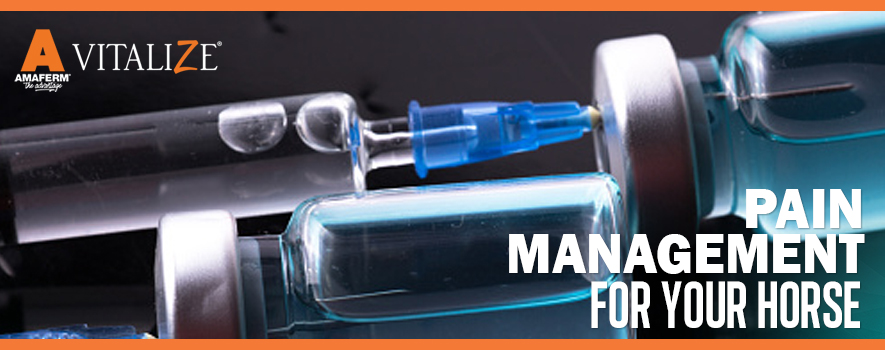Pain is a kind of perception, much like tasting or smelling. Every painful sensation is created by the brain to alert the body of a harmful situation. Pain is initiated by receptors at nerve endings, which detect a hazard and send a message thru the nerves to the spinal cord. The spinal cord then sends the signal to the brain, which processes and translates the threat into pain. These three physiological stages of pain have become the main targets of pain medication.
Local anesthetics target receptors at nerve endings to relieve pain in a particular area from where it originates. The anesthetics block nerve transmission to the central nervous system by preventing sodium ions, necessary for a nerve impulse, from traveling across nerve cell membranes and into the nerve cell. Local anesthetics are often used for “blocking” a nerve to diagnose and localize lameness. They can also be used to numb areas for invasive procedures such as surgery. The two most common local anesthetics used in equine veterinary medicine are lidocaine and mepivacaine.
Non-steroidal anti-inflammatory drugs (NSAIDs), including phenylbutazone (bute), banamine, firocoxib (Previcox) and ketoprofen, are the most common class of drug used for pain management in horses. In general, NSAIDs alleviate pain by blocking an enzyme called cyclooxygenase (COX). These enzymes produce prostaglandins (hormones) that promote inflammation, pain and fever. However, NSAIDs often come with adverse side effects due to the diversity of biological processes that are reliant on prostaglandins. In particular, one function of prostaglandins is to act on parietal cells in the stomach wall to inhibit acid secretion. This is one reason why gastric ulcers are often caused by NSAID use.
The last class of pain killer we will discuss are the centrally acting analgesics, which work by altering the way the pain signal is received and processed by the brain. These pain relievers are generally very potent and also act as sedatives. In horses, the most common centrally acting analgesics used are detomidine (Dormosedan), butorphanol (Torbugesic) and morphine. These are used for relieving pain and providing sedation for minor surgeries or husbandry procedures. Another commonly used centrally acting drug is methocarbamol (Robaxin), which is used as a muscle relaxant to treat skeletal muscle injury, strain or spasm. Methocarbamol may also result in mild sedation, but it’s effect is far less dramatic than detomidine, which requires the horse be monitored until the sedation has worn off.
In addition to these traditional veterinary medicine approaches to pain management, several alternative methods are emerging. These include acupuncture, physical therapy, herbal treatments and nutraceuticals. Acupuncture originated in Chinese medicine and has been used to treat every type of pain. Its success seems highly dependent on the horse and acupuncturist. Physical therapy for pain management includes the use of therapeutic lasers, ultrasounds and magnets, as well as more simple approaches such as applying a cold compress. Herbal supplements and nutraceuticals are also becoming more common. Several supplements that utilize devil’s claw, white willow bark, turmeric, or other herbs can now be found in many feed or tack stores. In addition, many nutraceuticals, such as glucosamine and hyaluronic acid for joint pain relief, are also available.
Whether you are using a traditional or alternative pain management routine, it is a good idea to keep a record of what medications were administered, how much was administered, the way it was administered and the time it was administered. If the horse is at a showing or showing in the near future, you should also check with your respective show organization (i.e. USEF, AQHA) to make sure you follow the drug and medication rules. If you haven’t, take a look at the rules at the beginning of each year. You may find some things on there you don’t expect to see. Also, remember that pain relievers often mask pain that is presenting itself for a reason!


